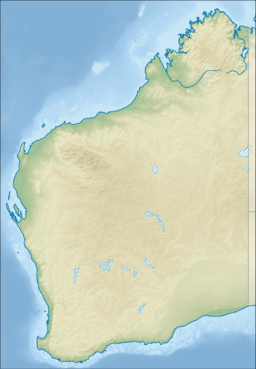Lake Warden (Western Australia) facts for kids
Quick facts for kids Lake Warden |
|
|---|---|
| Location | Goldfields-Esperance, Western Australia |
| Coordinates | 33°49′05″S 121°52′22″E / 33.81806°S 121.87278°E |
| Type | Saline |
| Primary inflows | Groundwater and surface runoff |
| Catchment area | 212,000 ha (523,863 acres) |
| Basin countries | Australia |
| Designation | Lake Warden Nature Reserve |
| Max. length | 3 km (2 mi) |
| Max. width | 2 km (1 mi) |
| Surface area | 590 ha (1,458 acres) |
| Average depth | 2 m (7 ft) |
| Surface elevation | 5 m (16 ft) |
| Official name: Lake Warden system | |
| Designated: | 7 June 1990 |
| Reference #: | 485 |
Lake Warden is a special salt lake found in the Goldfields-Esperance area of Western Australia. This lake and the wet, marshy areas around it are protected as a nature reserve. They are so important that they were recognized internationally on June 7, 1990. This happened under the Ramsar Convention, which protects important wetlands around the world. Lake Warden is also listed as a DIWA-listed wetland.
Contents
Where is Lake Warden Located?
Lake Warden is about 5 kilometres (3 mi) north of Esperance. You can find it between the two main roads that lead into the town. These roads are the South Coast Highway and the Coolgardie-Esperance Highway. The lake is part of the Esperance Lakes Nature Reserve.
The explorer John Septimus Roe named Lake Warden in 1848. He named it after Lady Ann Warden Spencer. She was the wife of Sir Richard Spencer, who was a government official in Albany. A nearby lake, now called Pink Lake, was named after her husband.
What is Lake Warden Like?
Lake Warden is usually about 2 metres (6 ft 7 in) deep. This depth has slowly increased since people started measuring it in 1979. The lake is now more than 1 metre (3 ft 3 in) deeper than it used to be. This change is mostly because of deforestation, which means many trees were cut down. When trees are removed, more water runs off the land into the lake.
The protected area, called the Ramsar site, covers about 2,000-hectare (4,900-acre). It includes Lake Warden and many other salty lakes and marshy areas. These are located behind the sand dunes near the beach. The Lake Warden system is very complex, with seven main lakes and over 90 smaller ones. This creates many different kinds of wetland homes for plants and animals. Besides Lake Warden, other important lakes in this system are Windabout, Woody, Station, Mullet, and Wheatfield Lakes.
The area that drains water into the lake is huge, covering 212,000 hectares (523,863 acres). About 80% of this land is used for farming. A large part of this farmland, about 95%, has been cleared of its natural plants.
Plants and Animals of Lake Warden
Many different plants and animals live around Lake Warden. Saltwater paperbark trees grow right at the water's edge in all the wetlands. You can also find sedges and rushes growing near the shoreline. Other trees like stout paperbark and red-eyed wattle are also common. These blend into low woodland areas with showy banksia or mallee eucalypt trees.
At the eastern end of the wetland system, you'll find different plants called samphire. These include Tecticornia and Sarcocornia species. Higher parts of the marsh have a lot of Stipa luncifolia grass. In areas where springs feed the water, you might see austral seabite.
The lake is a home for many waterbirds. It often supports between 20,000 and 30,000 birds! Some of the important species you can see here include the Australian shelduck, black swan, chestnut teal, grey teal, freckled duck, musk duck, pink-eared duck, hardhead, banded stilt, hoary-headed grebe, Australian pelican, and yellow-billed spoonbill.
Lake Warden is also very important for the hooded plover. This bird is an endemic Australian species, meaning it's only found in Australia. It is also a threatened species. There are fewer than 10,500 hooded plovers in the world, and less than 6,000 in Western Australia. Once, over 240 hooded plovers were counted at Lake Warden. This was 2.4% of the world's population and 4% of Western Australia's population! The Southwestern Cape Barren goose, which is considered vulnerable (at risk of extinction), was also seen at Lake Warden Nature Reserve in the 1980s.
Because of the large number of important birds it supports, BirdLife International has named Lake Warden an Important Bird Area (IBA). This means it's a crucial place for bird conservation.
Gallery






